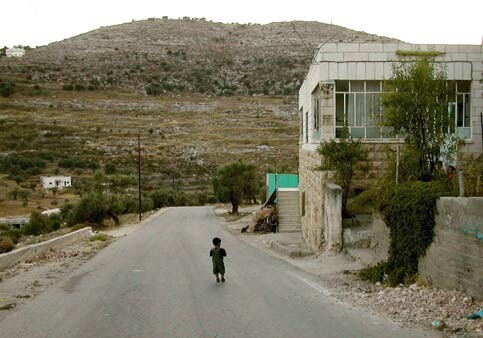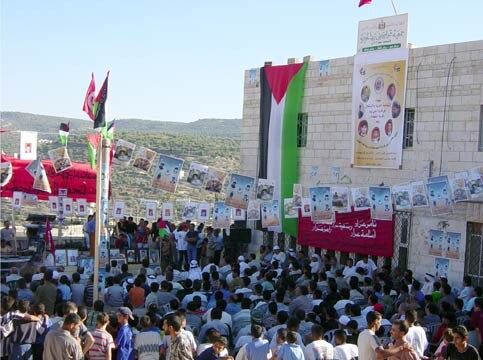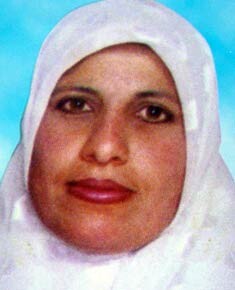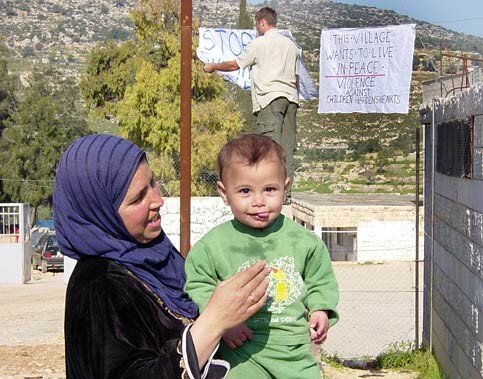The Electronic Intifada 20 January 2005

A child stands in the road in the village of Qarawat Bani Zeid. (IWPS)
Two innocent Palestinians were killed by the Israeli Occupation Forces (IOF) on 12 January 2005. Although they were the latest in a long line of Palestinian victims, and from a tiny village near Ramallah, they made headlines all over the world.
They were the first Palestinians to be assassinated by the IOF since the election of Mahmoud Abbas, which had taken place just three days before. The so-called ‘period of restraint’ had come to an abrupt end with the killings. For this reason, the assassinations were portrayed by the commercial media as a necessary response to two violent militants who had opened fire at Israeli soldiers.
However, eyewitnesses on the ground report an entirely different story.
Members of the International Womens’ Peace Service (IWPS) have lived on and off in Qarawat Bani Zeid since five children were assassinated there by the IOF in 2003. IWPS activists reported that they arrived in the village about 40 minutes away from their base, in response to urgent phone calls from residents, just in time to see the bodies of the two slain Palestinians being taken out of the house and into the ambulance.
According to IWPS the IOF had invaded the village three times in the ten days prior to the assassination — all through the election period. During this time, they had not given any indication that they were searching for wanted militants but seem rather to have been making a general nuisance of themselves — shooting sound and smoke bombs into houses and leaving in a hurry.
During this period the IOF also arrested Majid and Sajeed Arar, 32 and 30 years old respectively, and carted them off to prison on charges unknown.
Villagers said that the two slain men, residents of the nearby villages of Deir Ghassana and Kufr Dik who were visiting Qarawat Bani Zeid, were not shooting at IOF soldiers but were assassinated in cold blood.
After the assassination, the IOF said that the two slain men had killed many soldiers, and so demolished the house they had been visiting. “The people of the village are adamant that this is not true, and that this accusation provided the excuse for the army to demolish the house,” said IWPS.
The demolition also resulted in the uprooting of many olive trees. The next day, the Shabak (Israeli Intelligence) came back and took many photos. The village asked IWPS to stay there for a few days and be visible in the streets to deter soldiers and Shabak from returning. There is to be a mass meeting in the village tomorrow to decide how they can get an international presence and how long this will be needed.
Although many foreign journalists live in Jerusalem which is only about one hour’s drive from Qarawat Bani Zeid, it was clear from the media reports that no journalist had attended the scene of the assassination. The assassinations were described in shamelessly contradicting ways. The men were described by some journalists as Hamas, by others as Islamic Jihad. The Israeli Foreign Ministry said the slain Palestinians were wanted for “attempting to obtain chemicals in order to manufacture additional explosive devices” and had opened fire on the IOF.
In fact, the assassinations represent a pattern of IOF killings that has turned this peaceful, pastoral village of 7,800 people into a living family tragedy.
Qarawat Bani Zeid village is situated in a valley surrounded by hills. The village has the misfortune of being just six kilometres away from the Hallamish settlement/military base from which nightly invasions are sometimes launched. These invasions seem to take place for little reason other than the amusement of the soldiers. For example, in September 2003, soldiers captured teenage Hamada Arar for no reason, taking him back to Hallamish military base and beating him very badly for several hours.
At midnight, they dumped Hamada’s body near the school. He was discovered in the morning by teachers and rushed to hospital. Later on that year in October, IOF soldiers beat and detained Khaled Arar, an ambulance driver from Qarawat Bani Zeid ,at a checkpoint. When he complained to soldiers that a small boy who had fallen from a roof needed to get to hospital, they grabbed his throat and hit him with the butts of their guns.
Villagers on their way home from Ramallah are often threatened by soldiers at the Halmiesh roadblock who tell the villagers that one day something unimaginable will happen to them. The soldiers say that the land is theirs.
The children of the village all whistle loudly when they see soldiers approaching. Soldiers often detain parents outside the village and warn them to tell the children not to whistle or they will kill them.
The IOF has also bombed nearby caves, causing panic and fear to the Palestinian shepherds who graze their animals on the surrounding land. Israeli settlers have tried to seize plots of land and have prevented farmers from picking olives.

A June 2003 memorial for all the villagers killed during the summer. (IWPS)
Since 2001, the IOF has killed ten villagers — eight of them from the Arar family. During the summer of 2003, IWPS activists attended five funerals in Qarawat Bani Zeid after the IOF gunned down Osama and Faker Arar in the schoolyard on the same day.
The IOF waited just six weeks before shooting Rasmeyeh Arar (a mother of six) in her head with a sniper rifle from the hills across the valley, as she ran outside after seeing her cousin Ramez Arar fall suddenly to the ground with a sniper bullet in his head. These Qarawat Bani Zeid residents were proud members of the Palestinian Peoples’ Party, a socialist party without an armed wing which believes in noniolent resistance to the Israeli occupation.

Ramez Arar was shot dead by an Israeli sniper on 22 May 2003. (IWPS)

Rasmeyeh Arar was killed by an Israeli sniper a few minutes after she ran out to Ramez’s body. (IWPS)

Tamer Arar was killed on 26 May 2003, as he sat in his garden eating bread and cucumber. (IWPS)
The IOF shot him several times and then stood over his body to prevent medical help. Sameh bled to death on the ground. The blood on the ground, surrounded by roses and weeping villagers, was still visible the next day. Later that night, the IOF arrested the Imam of the village who Sameh had been breakfasting with, and then returned to Sameh’s house at 3am to taunt his grieving young widow, shouting “we killed Sameh” over a megaphone.
The point of all this information is that, behind every Associated Press and CNN story about another gun-toting militant shot by the IOF in an ‘operation’, lies a totally alternate truth. The truth in this small village is that a slow, and sometimes not so slow, genocide is taking place. A family made up of peace-loving people who wake up in the morning to pick olives, drink coffee, hang out with neighbours and friends, or go to school are being picked off one by one.

A mother and child in Qarawat Bani Zeid stand near a banner that says “This Village wants to live in peace. Violence against children hardens hearts.” (IWPS)
Related Links
Anna Weekes is a member of the Cape Town Anti-War Coalition in South Africa.

